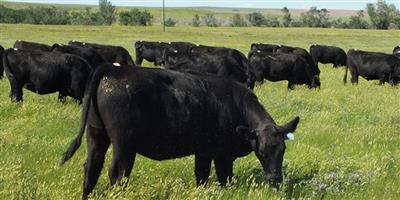The warmer spring temperatures have been a welcome reprieve from the cold experienced across the region in 2019. With warmer temperatures and significant soil moisture, ranchers need to be proactive in mitigating grass tetany risk. Cool season grasses are beginning to green up, posing a risk for cows with young calves. As the temperatures continue to increase, cool season grasses, such as crested wheatgrass will grow rapidly, increasing the risk of grass tetany. Having a solid understanding of the risk factors and how to mitigate risk will be key.
Grass tetany is a metabolic disorder associated with grazing lush pastures, resulting in low concentrations of blood magnesium, which results in nerve impulse failure in animals. With adequate moisture and warm temperatures, grasses will grow rapidly. Grass tetany isn’t normally seen until May but taking steps now to prevent it will be more effective in the long run. It is never too early to plan and ensure proper management practices are in place.
Understanding the factors that influence the progression of grass tetany will help one manage risk. These factors include:
- Low magnesium (Mg) coupled with high potassium (K) content of rapidly growing forages
- High crude protein content of forages
- Bad weather, storms, stress, etc., that cause cattle to be “off feed” for 24-48 hours
- Lactation due to losses of Mg and calcium (Ca) in milk
- Various combinations of the above factors resulting in low blood Mg or Ca
Older, lactating cows with calves younger than 2 months of age have the greatest susceptibility to tetany. Mature cows are more susceptible because they are less able to mobilize Mg from bones to maintain the necessary Mg level in their system. Also, cows within two months after calving have increased milk production which requires additional Ca and Mg. Steers, heifers, dry cows, cows with calves older than 4 months of age and bulls are less susceptible.
Prevention is key to minimizing risks associated with lactating cows grazing lush pastures. If possible, delay turn-out until plants are 4 to 6 inches tall. This will reduce the occurrence of tetany in addition to giving pastures more rest and recovery. Unfortunately, reality is that many pastures are needed when grasses begin to green-up and the risk for tetany is highest.
If delayed turn-out is not an option, other management tools should be utilized. First, always provide a high magnesium (Mg) supplement containing 8-12% Mg at 3-4 oz. intake. For a cooked molasses product with a recommended intake of approximately 1 pound, the guaranteed analysis for Mg should be approximately 4%. Read the label to ensure adequate Mg levels and recommended intake. Magnesium supplements need to be offered two to three weeks prior to turn-out or before tetany is likely to occur. Palatability and adequate intake can be challenging, resulting in some animals consuming an inadequate amount of mineral on a daily basis. Ensure all animals have access to the supplement prior to and while grazing tetany-prone pastures to help decrease the occurrence.
Another option is to provide hay while cattle are grazing lush pastures; however, they are not likely to eat hay unless forced to. Dry forages can act as carriers to provide additional Mg and Ca at critical times. If the water source is contained (i.e., water tanks), soluble Mg salts can be added. Some examples of soluble Mg salts are magnesium acetate, magnesium chloride, and magnesium sulfate (Epsom salts). The most common form of Mg found in supplements, magnesium oxide, is not soluble in water and therefore cannot be used for this purpose.
A long term approach is to incorporate more legumes into pasture mixes. Legumes have higher levels of Mg and Ca than do immature grasses resulting in a better balance across the pasture. As the pastures green-up, cattle will have access to both types of forage, helping to alleviate the tetany risk.
Death can occur very rapidly therefore symptoms may not be observed. Symptoms progress over 4 to 8 hours as follows: grazing away from the herd, irritability, muscle twitching in the flank, wide-eyed and staring, muscular incoordination, staggering, collapse, thrashing, head thrown back, coma, and finally death. Affected animals should be handled calmly because stress can cause sudden death.
Treatment options are available, but effectiveness depends on the clinical stage when administered. If treatment is started one or two hours after clinical signs develop, the results are usually a quick recovery. Treatment is not effective if delayed until the coma stage. Grass tetany can be treated with an intravenous dextrose-based commercial preparation of magnesium and calcium purchased from a local veterinarian.
Remember cattle are more susceptible to grass tetany in the spring with weather events increasing risk. Determine and implement prevention practices, monitor cattle for symptoms, and treat as soon as possible according to a protocol developed with your veterinarian.
###
Adele Harty – SDSU Extension Cow/Calf Field Specialist
South Dakota State University Extension


